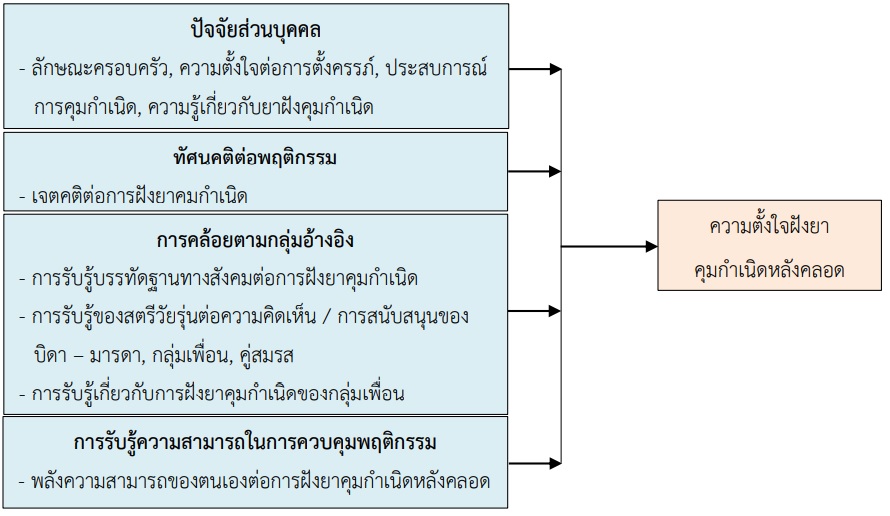ปัจจัยที่มีความสัมพันธ์กับความตั้งใจในการฝังยาคุมกำเนิดหลังคลอดของสตรีตั้งครรภ์วัยรุ่น
คำสำคัญ:
ยาฝังคุมกำเนิด, การตั้งครรภ์วัยรุ่น, ความตั้งใจคุมกำเนิด, ทฤษฎีพฤติกรรมตามแผนบทคัดย่อ
การวิจัยเชิงบรรยายแบบหาความสัมพันธ์นี้ มีวัตถุประสงค์เพื่อศึกษาปัจจัยที่มีความสัมพันธ์กับความตั้งใจในการฝังยาคุมกำเนิดหลังคลอดของสตรีตั้งครรภ์วัยรุ่น กลุ่มตัวอย่าง คือ สตรีตั้งครรภ์วัยรุ่นที่มีอายุน้อยกว่า 20 ปี ที่เข้ารับบริการฝากครรภ์ ที่แผนกฝากครรภ์ โรงพยาบาลมหาสารคาม จำนวน 96 ราย เครื่องมือที่ใช้ในการวิจัย ประกอบด้วย 1) แบบสอบถามข้อมูลส่วนบุคคล 2) แบบสอบถามความรู้เกี่ยวกับยาฝังคุมกำเนิด 3)แบบสอบถามเจตคติต่อการฝังยาคุมกำเนิด 4) แบบสอบถามการรับรู้บรรทัดฐานทางสังคมต่อการฝังยาคุมกำเนิด 5) แบบสอบถามพลังความสามารถของตนเองต่อการฝังยาคุมกำเนิดหลังคลอด 6) แบบสอบถามการสนับสนุนทางสังคม ได้ค่าความตรงตามเนื้อหา ของแบบสอบถามลำดับที่ 2 - 5 เท่ากับ .92, .84, .80 และ .90 ตามลำดับ ค่าสัมประสิทธิ์แอลฟาของครอนบราค ของแบบสอบถามลำดับที่ 2-6 เท่ากับ .72, .77, .90, .78 และ .87 ตามลำดับ วิเคราะห์ข้อมูลด้วยสถิติความถี่ ร้อยละ ค่าเฉลี่ย ส่วนเบี่ยงเบนมาตรฐาน ไคสแคว์ และสถิติถดถอยพหุลอจิสติกส์ ผลการวิจัยพบว่า
กลุ่มตัวอย่างสตรีตั้งครรภ์วัยรุ่น 36 ราย (ร้อยละ 37.50) ตั้งใจที่จะฝังยาคุมกำเนิดหลังคลอด ปัจจัยที่มีความสัมพันธ์กับความตั้งใจในการฝังยาคุมกำเนิดหลังคลอดของสตรีตั้งครรภ์วัยรุ่น อย่างมีนัยสำคัญทางสถิติ (p<.05) ได้แก่ ประสบการณ์การคุมกำเนิดก่อนตั้งครรภ์ (OR=0.225, 95%CI=0.057-0.891) และพลังความสามารถของตนเองต่อการฝังยาคุมกำเนิดหลังคลอด (OR=6.677, 95%CI=1.339-33.561)
ควรหาวิธีการหรือกลยุทธ์ในการดูแลส่งเสริมให้สตรีตั้งครรภ์วัยรุ่นมีความตั้งใจในการฝังยาคุมกำเนิดหลังคลอด โดยเฉพาะในกลุ่มที่ไม่เคยคุมกำเนิดก่อนตั้งครรภ์มาก่อน หรือจัดกิจกรรมเพื่อเพิ่มพลังความสามารถของตนเองของสตรีตั้งครรภ์วัยรุ่นเกี่ยวกับความตั้งใจในการฝังยาคุมกำเนิดหลังคลอด ตั้งแต่อยู่ในระยะตั้งครรภ์ เพื่อให้สตรีตั้งครรภ์วัยรุ่นตัดสินใจเลือกฝังยาคุมกำเนิดในระยะหลังคลอด เพื่อป้องกันการตั้งครรภ์ซ้ำในสตรีตั้งครรภ์วัยรุ่น
เอกสารอ้างอิง
Aeamsamarng, P., Srisuriyawet, R., & Homsin, P. (2013). Risk Factors of Unintended Repeat Pregnancy among Adolescents. The Public Health Journal of Burapha University, 8(1), 55-67. (in Thai)
Ajzen, I. (1991). The Theory of Planned Behavior. Organ Behav Hum Decis Process, 50(2), 179-211.
Alemayehu, M., Belachew, T., & Tilahun, T. (2012). Factors Associated with Utilization of Long-Acting and Permanent Contraceptive Methods among Married Women of Reproductive Age in Mekelle Town, Tigray Region, North Ethiopia. BMC Pregnancy and Childbirth, 12(6), 1-9.
Asnong, C., Fellmeth, G., Plugge, E., Wai, N S., Pimanpanarak, M., Paw, M K., et al. (2018). Adolescents’ Perceptions and Experiences of Pregnancy in Refugee and Migrant Communities on the Thailand-Myanmar Border: a Qualitative Study. Reproductive Health, 15(83), 1-13.
Boonyamalik, P. (2005). Epidemiology of Adolescent Suicidal Ideation: Role of Life Stress, Depressive Symptoms and Substance Use (Thailand). Unpublished Dissertation, Johns Hopkins University, US.
Bureau of Reproductive Health, (2020). Department of Health, Ministry of Public Health, Thailand. Teenage pregnancy. (Internet). (cited 2021 Nov 1). Available from: https://rhold.anamai.moph.go.th/main.php?filename =index.
Chacko, M. R., Wiemann, C. M., Buzi, R. S., Kozinetz, C. A., Peskin, M., & Smith, P. B. (2016). Choice of Postpartum Contraception: Factors Predisposing Pregnant Adolescent to Choose Less Effective Methods Over Long-Acting Reversible Contraception. Journal of Adolescent Health, 58, 628-635.
Chunin, R., Saejeng, K., & Sukrat, B. (2016). Contraceptive Service Provision of Hospitals in Thailand in 2015. Bureau of Reproductive Health, Department of Health, Ministry of Public Health, Thailand, 39(2), 1-118. (in Thai)
Gage, A. J., Wood, F. E., & Akilimani, P. Z. (2021). Perceived Norms, Personal Agency, and Postpartum Family Planning Intentions among First-Time Mothers Age 15–24 Years in Kinshasa: A Cross-Sectional Analysis. PLOS ONE, 16(7), 1-24.
Intharueang, U., Masingboon, K., & Wacharasin, C. (2015). A Causal Model of Contraceptive Behavior among Female Adolescents. Journal of Nursing and Health Care, 33(4), 43-53. (in Thai).
Jumklang, S., Srisuriyawet, R., & Homsin, P. (2017). Correlated Factors with Decision Making of Birth Control Implant Used Based on the Information-Motivation Behavioral Skills Model (IBM Model) among Teen Mothers. The Journal of Faculty of Nursing Burapha University, 25(2), 31-42. (in Thai).
Kiene, S. M., Hopwood. S., Lule, H., & Wanyenze, R. (2014). An Empirical Test of the Theory of Planned Behaviour Applied to Contraceptive Use in Rural Uganda. J Health Psychol, 19(12), 1564–1575.
Krungkaew, P., Phahuwatanakorn, W., & Pungbangkadee, R. (2021). Predictabilty of Knowledge, Attitude, Subjective Norm and Perceived Behavior Control on Intention to the Use of Long-Acting Reversible Contraception among Primipara Pregnant Adolescents. Nursing Science Journal of Thailand, 39(1), 64-76. (in Thai).
Luttges, C., Leal, I., Huepe, G., Gonzalez, D., Gonzalez, E., & Molina, T. (2021). Pregnant Again? Perspectives of Adolescent and Young Mothers who and do Not Experience a Repeat Pregnancy in Adolescence. International Journal of Qualitative Study on Health and Well–Being, 16, 1-12.
Maslowsky, J., Stritzel, H., Hamoodah, L. A., Hendrick, E., Powers, D., Gutierrez, T. B., et al., (2021). Health Behaviors and Prenatal Health Conditions in Repeat Vs First-Time Teenage Mothers in the United States: 2015-2018. Journal of Pediatric and Adolescent Gynecology, 34(1), 47-53.
Rueankhong, W., Suthutvoravut, S., & Tangthitawong, J. (2018). Factors Associated With the Use of Subdermal Etonogestrel Implants Among Postpartum Primipara Adolescents. Ramathibodi Medical Journal, 14(1), 9-16. (in Thai).
Somroop, A., Deoisres, W., & Suppaseemanont, W. (2019). Factorss Influencing the Use of Postpartum Contraceptive Implants among Primiparous Adolescents. 2019. The Journal of Faculty of Nursing Burapha University, 27(3), 79-87. (in Thai).
Talungchit, P., Lertbunnaphong, T., & Russameecharone, K. (2017). Prevalence of Repeat Pregnancy Including Pregnancy Outcome of Teenage Women. Siriraj Medical Journal, 69(6), 363-368. (in Thai)
Wattanathamrong, V., Sirisopon, N., Kainakha, P., Onsiri, S., Amitpie, C., Anek, A., et al. (2017). Factors Related Intention Contraception Type Implants in Repeat Pregnancies Adolescents. Journal of The Royal Thai Army Nurses, 18(1), 102-11. (in Thai).
Wikie, G. L., Leung, K., Kumaraswami, T., Barlow, E., & Simas, T. A. M. (2016). Effects of Obstetric Complications on Adolescent Postpartum Contraception and Rapid Repeat Pregnancy. J Pediatr Adolesc Gynecol, 29, 612-616.
Wisarutkasemopng, A., & Muangpin, S. (2015). Factors Related to the Intention to Repeat Pregnancy among Pregnant Adolescents. Srinagarind Med J, 30(3), 262-269. (in Thai)

ดาวน์โหลด
เผยแพร่แล้ว
ฉบับ
ประเภทบทความ
สัญญาอนุญาต
ลิขสิทธิ์ (c) 2022 วารสารการพยาบาลและการศึกษา

อนุญาตภายใต้เงื่อนไข Creative Commons Attribution-NonCommercial-NoDerivatives 4.0 International License.





